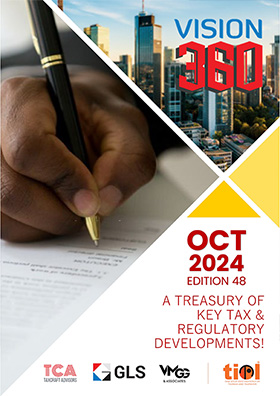Gujarat HC Larger Bench upholds Division Bench decision in Vodafone MAT case; rules if assessee provisions amount for bad debts and reduces corresponding sum from loans in books, it amounts to write-off and it is not hit by Clause(i) to Explanation 1 to Sec 115JB
By TIOL News Service
AHMEDABAD, AUG 09, 2017: THE issue before the Larger Bench is - Whether after retrospective insertion of Clause (i) to Explanation 1 of Sec 115JB any amount set aside for provision for diminution in the value of the asset made by the assessee, would be added back for computation of book profit under section 115JB. YES is the verdict.
Facts of the case
The assessee is a registered company. For the AY 2003-2004, the assessee had filed NIL return. The Assessing Officer issued Sec 148 notice to reopen the assessment. The AO did not agree with the assessee provisioning a sum of Rs 6.3 Cr for bad and doubtful debts. The Assessing Officer added such sum for computing the book profit of the assessee for the purpose of Minimum Alternative Tax ['MAT'] liability under section 115JB of the Act. The CIT(A) allowed the assessee's appeal and the Tribunal held that the the provision for bad and doubtful debts cannot be termed as a provision for liability but was in the nature of diminution in the value of asset.
On appeal, the HC held that,
++ the Supreme Court in case of HCL Comnet Systems and Services Ltd. held that clause (c) of the explanation would apply to the debt payable by the assessee. In such a case, if the amount is set aside as a provision and provision is made for meeting a liability other than ascertained liability, clause (c) would come into force and such provision would be added in computation of book profit for the purpose of 115JA of the Act. This clause, however, would not cover a provision made for a debt which is receivable by the assessee. It was observed that the provision for bad and doubtful debts which is made to cover up probable diminution in the value of the asset, cannot be said to be a provision for liability because even if the debt is not recoverable, no liability could be fastened on the assessee;
++ to overcome such view of the Supreme Court, the Revenue added clauses (g) and (i) to the explanations in section 115JA and 115JB of the Act respectively with retrospective effect. With such addition now the book profit for the purpose of section 115JB of the Act would be increased by the amount or amounts set aside as provisions for diminution in the value of any asset. The explanatory note for introduction of such amendment clarified that the new clause (i) was inserted "so as to provide that if any provision for diminution in the value of any asset has been debited to the profit and loss account, it shall be added to the net profit as shown in the profit and loss account for the purpose of computation of book profit." This legislative change thus was clearly necessitated on account of the judgment of the Supreme Court in case of HCL Comnet Systems and Services Ltd. holding that under clause(c) to the explanation any provision for bad or doubtful debts for diminution in the value of any asset cannot be added to the book profit of the assessee;
++ this Court in Deepak Nitrite Limited, held that in view of such statutory change, the decision of Supreme Court in case of HCL Comnet Systems and Services Ltd, would allow the Revenue to make such addition. Delhi High Court in case of Commissioner of Income-tax v. ILPEA Paramount (P) Ltd 2010-TIOL-155-HC-DEL-IT had come to similar conclusion. Seen from this light and in this context, the decision in case of Deepak Nitrite Limited, lays down the correct proposition;
++ decisions of Supreme Court in cases of Southern Technologies Ltd and Vijaya Bank bring out a clear distinction between a case where the assessee may make a provision for doubtful debt and a case where the assessee after creating such a provision for bad and doubtful debt by debiting in Profit and Loss account also simultaneously removes such provision from its account by reducing the corresponding amount from the loans and advances on the asset aside of the balance sheet. The later would be an instance of write-off and not a mere provision;
++ Karnataka High Court in case of Yokogawa India Ltd. applying such principle found that case on hand was one of a debt which was an amount receivable by the assessee and not any liability payable by the assessee and observed that clause(c) of the explanation to section 115JA/115JB, would not apply. In context of applicability of clause(i) to the explanation, relying on the decision of Supreme Court in case of Vijaya Bank, the Court observed that there is a dichotomy between actual write off and provision for bad and doubtful debt. A mere debit to the Profit and Loss account would constitute a bad and doubtful debt but it would not constitute actual write off. However, if simultaneously such amount is obliterated from the accounts by reducing corresponding loans and advances on the asset side, the same would amount to a write off;
++ by way of culmination of above judicial pronouncements and statutory provisions, the situation that arises is that prior to the introduction of clause(i) to the explanation to section 115JB, as held by the Supreme Court in case of HCL Comnet Systems and Services Ltd, the then existing clause (c) did not cover a case where the assessee made a provision for bad or doubtful debt. With insertion of clause (i) to the explanation with retrospective effect, any amount or amounts set aside for provision for diminution in the value of the asset made by the assessee, would be added back for computation of book profit under section 115JB of the Act. However, if this was not a mere provision made by the assessee by merely debiting the Profit and Loss Account and crediting the provision for bad and doubtful debt, but by simultaneously obliterating such provision from its accounts by reducing the corresponding amount from the loans and advances on the asset side of the balance sheet and consequently, at the end of the year showing the loans and advances on the asset aside of the balance sheet as net of the provision for bad debt, it would amount to a write off and such actual write off would not be hit by clause (i) of the explanation to section 115JB. The judgment in case of Deepak Nitrite Limited fell in the former category whereas from the brief discussion available in the judgment it appears that case of Indian Petrochemicals Corporation Ltd, fell in the later category;
++ in our view, there is no conflict between the two judgments and both operate in different fields. Reference is answered accordingly.
(See 2017-TIOL-1527-HC-AHM-IT-LB)















